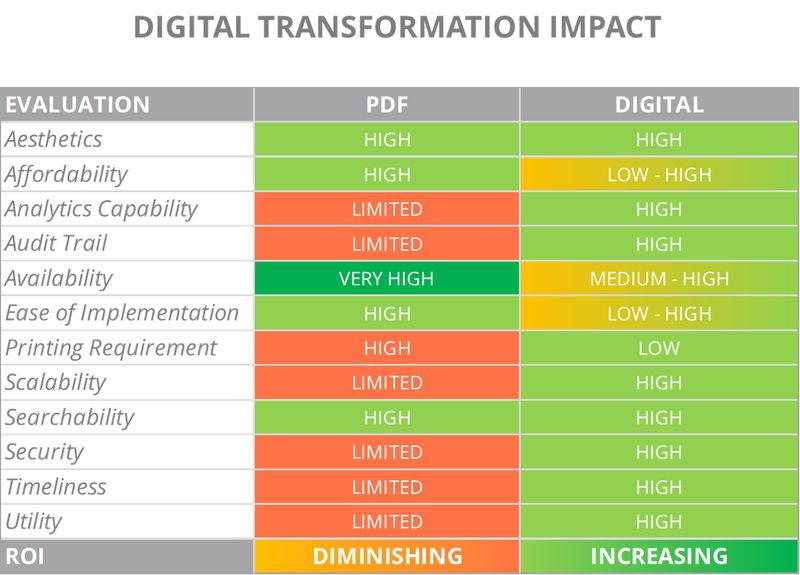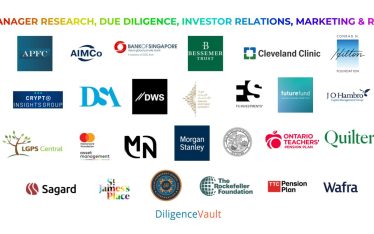PDF documents are a leading, secure means of sharing information. To many, the necessity of PDF files as a tool for disseminating information seems undisputed. But as data flows have accelerated and information types have become complex, PDF limitations have contributed to the rise of digital alternatives. This blog explores the pros and cons of PDFs vs digital solutions.
Security
PDF technology provides write protection for digital documents so that the information cannot be altered. PDF files can be password protected to restrict access, although credentialing use of a single document is onerous and inefficient. A PDF file that is not password-protected can be forwarded to and viewed by anyone. A PDF may be watermarked to prevent circulation beyond intended recipients, but this would not prevent a breach of security, just identify the culprit after the fact. A PDF file can also include limited metadata pertaining to title, author and date.
Digital platforms can also prevent data from being tampered with, and any manipulation of digital data leaves digital fingerprints. Digital platforms should provide data security via encryption, both in transit and at rest. Digital platforms provide a time-stamped audit trail of all metadata. When configured appropriately, access to digital information allows added protections of multi-factor authentication, IP address whitelisting, and security around failed attempts to gain access. The dissemination of digitized information can be closely controlled so that it is not shared with unintended recipients.
Implementation: Ease, Availability, and Cost
PDF software is widespread, inexpensive, and multi-platform, working with a variety of software regimes. Compression technology allows PDF files to be transferred quickly and easily. Virtually everybody and all organizations can access information in PDF format.
Digitization is a newer phenomenon, growing in adoption, and becoming more widespread. Digitized information can be transferred between platforms and providers quite readily via increasingly common API interface.
Depending on the platform, the scope of functionality, and the size of the organization, the cost of digitization can range from very affordable to a significant investment. Digital technology is becoming increasingly ubiquitous and affordable, with flexible off-the-shelf solutions for a wide variety of applications.
Utility with PDFs is One-Sided
PDF documents are created to present polished, coherent content on a page or within a file. A PDF document has generally been through a significant process of writing, revisions, and formatting. The appearance matters, sometimes more so than the content. Once the content has been created, generally in a Word, PowerPoint or Excel document, future versions of the file can be updated with relative ease in the initial format and then saved as a PDF. Content is searchable within the PDF, unless the file is saved as an image, which then requires access to more expensive OCR technologies.
Most efficiency benefits of the PDF accrue to the creator, who is attempting to communicate a great amount of content to the widest audience possible. Therefore, the data set within the PDF contains little relevant information for many recipients, and much information relevant to few recipients. Moreover, the document is an end unto itself, with content to lend it coherence.
Expensive Structured Data
Utility is diluted for the PDF content consumer, who must sort through all content to find the information that matters to them, and then copy and paste to aggregate usable information. For this reason, it is difficult to extract information from a PDF, particularly at scale. Capability around digitized data extraction from PDFs is promising, but the quality assurance process is largely manual. Write protection effectively traps information within the PDF, rendering it inert.Any further processing or communication around the information contained in the document is beyond the scope of the file. How ironic that the fundamentally inert PDF has been the industry standard for information exchange!
Utility with Digitization is Multifaceted
Consider the process of using a digital platform to exchange information. Digitization involves parsing and structuring data at source, both qualitative and quantitative. Since collaboration and content management can be centralized, initial data preparation involves less work than creating a PDF. Digitized content is easily repurposed and further distributed. With NLP functionality such as information classification and recommendation algorithms, it takes little to no effort to respond to multiple iterations of requests for mostly the same information. The content creator can focus on creating quality content that differentiates their firm and their messaging, because s/he is not spending time on manual copy/paste tasks that have been automated.
Digitized content lends itself readily to further processing. Almost by definition, digitization is the prioritization of content over form, utility over aesthetics. The potential for analytics, benchmarking, and process oversight is unlimited, Vaulting the capabilities of users into a whole new universe! (Yes, pun intended! 😊) Digitization liberates the data from the document, bringing the triumph of substance over form!
Timeliness and Scalability
A PDF document is frozen in time (although the original underlying document can be revised) and it may or may not show a date. Digitized content, in contrast, provides a readily visible time-stamped audit trail. As the world of work is increasingly populated with digitally native millennials and Gen Z, who demand timeliness, they drive the ascent of the digitized mode as the quickest means to transfer information.
Then there is the ubiquity of information, which everyone agrees is simply overwhelming. There is more and more data, and it just keeps coming! Not so long ago, the ability to work with information at scale was limited to quantitative data. But now given the adoption of cloud platforms and BI and NLP technology, whether information is qualitative or quantitative, the only way to work with it efficiently at scale is with a digital solution. In a world of streaming data, the PDF is a relic.
The Buck Stops Here: ROI
What does digitization mean for the investment management industry? This is a competitive industry that attracts highly trained and accomplished professionals used to analyzing information. The promise of technology means that it is not economically viable to have expensive talent enslaved to manual processes around precious PDFs. The sheer volume of data combined with the fiduciary demands of investment professionals require an institutional scale solution, and scale means digital.
Ensuring the best possible ROI means replacing manual efforts with automation and digitizing where possible to cut down on costs and unleash the analytics potential of data. Digital technology can help with both the top line and bottom line. Further, as we make advancements with climate week commitments, it’s significant to note that digitization also reduces the burden to print documents. Since 2003, the DocuSign digital signature platform has helped hundreds of millions of people around the world replace over 20 billion sheets of paper with an eco-friendly digital process. This has resulted in preserving over 2.5 million trees required to make paper.Just think about the possibilities of increasing digitization!
Have you explored the potential of digitization as the solutions are rapidly evolving? Just take a look! The more you delay, the more acute the problem becomes and the more progress you miss. Where is your ROI and where would you like it to be? You may find that your future is now!



